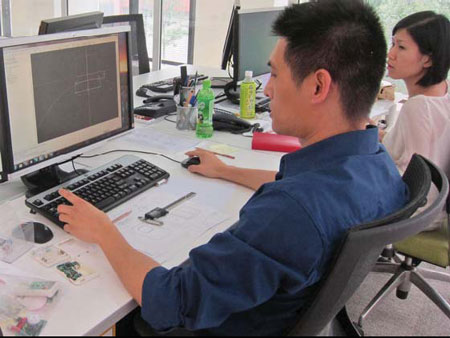Design factories
Updated: 2012-04-20 08:43
By Todd Balazovic (China Daily)
|
||||||||
Development plan
China first voiced the need for quality creators in 2007, when Premier Wen Jiabao gave instructions "to attach great importance to industrial design". His call was echoed in the long-term scientific and technological development plan (2006-20), which cast industrial design as a necessity for China's economic development.
Wen was foreshadowing China's need to move beyond making goods and start coming up with innovative ideas of their own.
Since making it a priority in 2006, Chinese industrial design has been showing amazing promise and continues to evolve on a daily basis.
In 2009, China was one of the top product creators, accounting for 50 percent of the world's industrial design filing activity, a 12.8 percent increase from 2008, according to a report from the World Intellectual Property Organization.
This was during a time when the other top two patent-filing countries, the US and Japan, showed little growth, with the US remaining almost unchanged, and Japan showing a 10.8 percent decrease in the number of patents filed.
Coupled with a whirlwind of new Chinese design schools - in the past 10 years more than 1,000 design schools have been opened across the country, sending talent trained at home by the thousands into an eager job market.
 |
|
The Shanghai office of the UK-based firm Industrial Design Consultancy, which offers design services mostly to Chinese companies. |
It is a stunning shift considering in the 1980s there were fewer than 10 design programs nationwide.
"Back in China 15 plus years ago, the concept of industrial design probably did not even come to mind to the average business owner," says Joseph Lam, business strategy manager at S.point Design, a Shanghai-based industrial design company.
As a result of their efforts, the industry in China has boomed.
Creative hubs
Industrial design "villages", massive creative hubs where several design companies share space, often at subsidized prices, have popped up across the country as China endeavors to create its own Silicon Valleys.
In Beijing alone, there are more than 250,000 jobs in industrial design, generating more than 80 billion yuan ($12.6 billion, 9.67 billion euros) in revenues each year, according to information provided by the Beijing Center for Industrial Design.
Compare this to the UK Design Council's most recent statistics that put the total number of jobs classified as industrial design in the UK at 25,520 total, generating about 157 billion yuan annually.
In the US, the numbers are similar, with the Department of Labor reporting a total of about 40,800 jobs in industrial design nationwide.
Staggering difference
While statistics on the industrial design as a whole are difficult to come by, if the numbers speak half the truth, the size difference between China and the West is staggering.
"(China) adapts to new technologies insanely fast - and this ability will help them to succeed. One day, they will surely manage it," says Vec from Red Dot Design.
But rapid growth is always beset with issues and creativity is rarely a skill measured by sheer numbers. There remains much work to be done for China to achieve its target of being truly innovative.
While the design industry in China may be ahead in numbers compared to the US or Europe, the quality and ingenuity of product design still has yet to come to fruition.
"Chinese companies are just now coming around to the value of in-depth design," says Clive Roux, executive director and CEO of the Industrial Design Society of America (IDSA).
"Most Chinese designers currently are focused too much on the aesthetic aspect of it, and they do not understand the deeper elements of design."
Roux, who spent seven years working as a design director for Philips Electronics in Hong Kong during the 1990s and still makes several visits to China annually, says that while there remains a lot of room for the Chinese industry to advance, it has made improvements.
"Where Chinese designers have really improved is in the tactics of design - the use of form and materials, color and texture. The sort of lower level tactical things you can do to help a company make their products more appealing," he says.
"Where I have seen them really lagging is in researching consumers and getting to the level of helping the company to figure out what their products should be based on the consumer."
The current focus on simply improving aesthetic design, rather than the function of the products themselves, limits the level of innovation going into new designs, he says.

 Relief reaches isolated village
Relief reaches isolated village
 Rainfall poses new threats to quake-hit region
Rainfall poses new threats to quake-hit region
 Funerals begin for Boston bombing victims
Funerals begin for Boston bombing victims
 Quake takeaway from China's Air Force
Quake takeaway from China's Air Force
 Obama celebrates young inventors at science fair
Obama celebrates young inventors at science fair
 Earth Day marked around the world
Earth Day marked around the world
 Volunteer team helping students find sense of normalcy
Volunteer team helping students find sense of normalcy
 Ethnic groups quick to join rescue efforts
Ethnic groups quick to join rescue efforts
Most Viewed
Editor's Picks

|

|

|

|

|

|
Today's Top News
Chinese fleet drives out Japan's boats from Diaoyu
Health new priority for quake zone
Inspired by Guan, more Chinese pick up golf
Russia criticizes US reports on human rights
China, ROK criticize visits to shrine
Sino-US shared interests emphasized
China 'aims to share its dream with world'
Chinese president appoints 5 new ambassadors
US Weekly

|

|







